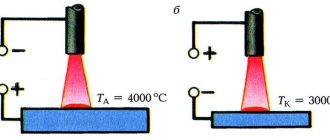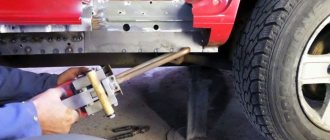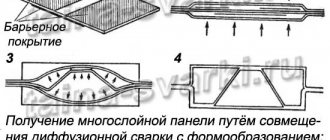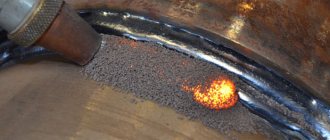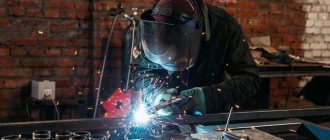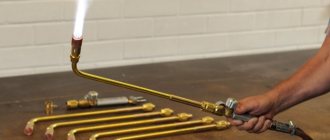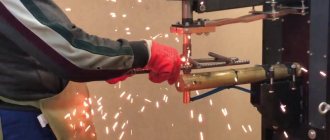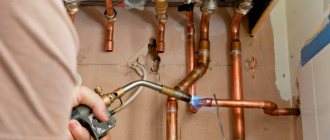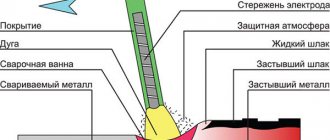According to GOST 2601-84, welding generally refers to the process of forming contact between elements at the atomic level, formed during heating or plastic deformation of individual parts of the products being welded.
From this definition it follows that the concept of welding can apply not only to metals, but also to plastics, glass and other non-metals, as well as their derivatives.
For a more accessible understanding of what pressure welding is, it is necessary to introduce such an important physical quantity as activation energy. It is responsible for the redistribution of interatomic bonds and their formation at a new level.
Welding principle
In the process of welding workpieces, activation energy is spent either on heating, which manifests itself in the form of melting of the contact site, or on its plastic deformation.
According to the definition, depending on the type of energy used to combine products at the interatomic level, fusion welding should be distinguished from the same procedure carried out under deformation. The latter principle is used in particular when welding pipes under pressure.
Known types of welding operations mainly differ in the nature of the physical and chemical processes occurring directly in the contact zone.
Fusion welding is based on the principle of heating it to a certain state, in which mixing of two joining parts occurs with the formation of a common liquid mass (welding pool).
Upon completion of the welding procedures and cooling of the pool, a connecting seam is formed, obtained directly from the melt and only partially through the use of special additives.
The source of local heating under classical fusion welding conditions can be:
- electric arc;
- gas burner flame;
- a chemical reaction accompanied by the release of a large amount of heat;
- energy of electronic origin;
- plasma or laser radiation.
A fairly narrow strip of material formed along the boundary of the parts or workpieces to be welded is called the fusion zone. Despite the small size of this formation (it is measured in microns), its influence on the quality of the welded joint is quite large.
Equipment required for work
Hot stamping machines are often used to carry out thermomechanical welding. Their peculiarity is the presence of a built-in induction heater, so the workpieces are heated directly at the work site and do not need to be moved from the furnace.
In other cases, hydraulic or mechanical presses are used; the choice is made depending on the plasticity of the materials. Upsetting is performed in modernized dies. They do not have a matrix; instead, workpieces are pressed along the connection line.
We recommend reading: How to cook with an autogenous oven yourself
Specific features
The principle of pressure welding is the plastic deformation of the metal material along the joints of the parts being welded (individual sections of pipelines, for example). This mechanical effect is achieved due to significant static loads, and in some cases, shock loads.
To speed up this process, welding is accompanied by local heating, which promotes the formation of stronger bonds between particles that come into direct contact. A strip of material with physical processes occurring within its boundaries is called a union zone.
As a heat source for hot pressure welding, both special thermal furnaces and electric or induction current, as well as special chemical reactions or an alternating electric arc can be used.
The pattern of the welding process under pressure with heating of the contact zone differs significantly from the case of fusion welding.
Thus, when welding joints under pressure with partial heating, the joints are first slightly melted and only then are they plastically deformed. At the same time, some part of the deformed material, together with the slag, is squeezed out beyond the boundaries of the joint, forming the so-called “burr”.
Features of weldability of metal alloys
If welding metal requires simple settings, and the work is performed in a wide range of parameters, then it has good weldability and vice versa. This indicator is not constant, and as technology and equipment improve, weldability will improve.
The weldability of materials is influenced by the melting temperature and electrical conductivity.
The weldability of materials is influenced by various factors:
- melting temperature;
- thermal and electrical conductivity;
- change in strength and expansion coefficient with increasing temperature;
- hardness.
The lower the electrical and thermal conductivity, the less current is required and the electrical power spent on heating the workpieces is reduced. Strong materials require a lot of force to deform; hard materials must be heated before joining. With a high coefficient of expansion, there is greater shrinkage, which leads to the appearance of cracks and cavities.
Features of some metals and alloys:
- low-carbon steels are well connected by resistance welding, are not prone to cracking, their strength practically does not decrease, and the weld is ductile;
- carbon ones are prone to hardening, so they work with them in “soft” modes; the ductility and strength of the joint are increased by heat treatment;
- stainless – have high resistance, so low currents are used, work is performed in “hard” mode;
- heat-resistant - strong when heated, therefore welding requires high pressure and a long current supply; in order to reduce the upsetting pressure, the welding zone is preheated;
- titanium alloys - when they are heated, their ductility increases, so low pressures are required, the work is performed with high intensity and at high currents, high upsetting rates and short temporary effects;
- copper - their welding requires high currents and a short duration of their flow;
- aluminum and magnesium - the work is performed by short-term pulses of high current, pressures similar to those used when welding low-carbon steels.
Resistance welding works well to join low-carbon steels.
Types of pressure welding
The following types of pressure welding are known:
- cold;
- using the friction effect;
- ultrasonic and forging.
Resistance welding (when the part is heated by electric current) can also be classified as a type under pressure. Its result depends largely on the compression force.
It is most widespread when connecting pipes and structural parts in mechanical engineering. Types of pressure welding such as diffusion welding and explosion joining are actively developing.
Cold
“Cold” pressure welding refers to the technique of joining parts and workpieces without melting the ends (only due to their mechanical compression with significant force).
At pressures significantly exceeding the limiting values for the structure of any metal, the effect of fluidity begins to appear at its joints. This is especially easy to achieve when, at normal temperatures, the material itself is sufficiently plastic.
Under the influence of compression pressure at the junction, one material diffuses into another with the simultaneous release of a certain amount of heat. Upon completion of the welding process, the parts connected in this way are gradually cooled.
As a result, natural seams of sufficiently high quality are formed, free from any unwanted internal stresses and residual effects observed due to overheating of the metal. This type of welding is used when it is necessary to join parts made of difficult-to-melt materials containing titanium, nickel, copper and their alloys.
The scope of possible application of this technique is limited by the need to involve rather expensive and complex special equipment in the welding process. Another disadvantage of the cold pressure welding method is its relatively low production efficiency.
Using friction effect
This type of joining of parts of a material is realized through the use of heat released during dynamic (rubbing) contact of the surfaces being welded.
To achieve the result, the workpieces being processed are fixed in the clamps of a special mechanism, one of which remains motionless during the operation. At this time, the second clamp performs rotational and translational vibrations controlled by the operator.
During the welding process, the workpieces being processed are first compressed due to axial pressure, after which a special rotational mechanism is activated. When the maximum friction temperature is reached (about 980-1300 degrees), the rotation of the workpieces stops, and their compression continues.
The advantages of this type of pressure welding include simplicity and reliability, as well as high productivity of the technological process. Low energy consumption and the ability to connect products from dissimilar materials should be added.
To implement the friction effect method, the industry produces special mechanisms capable of welding plastic workpieces.
The method is widely used for joining difficult-to-weld dissimilar metals. An example would be options for connecting steel with aluminum or austenitic materials with pearlitic ones.
Ultrasonic and forging
Welding using ultrasound is another method of joining materials of dissimilar composition that are in a solid state under pressure. The use of this method is most effective when welding modern polymers manufactured in the form of sheet products.
With its help, almost all types of the most common polymer materials are perfectly combined. It can also be used to join artificial leather products, as well as natural fabrics containing synthetic fibers.
The ultrasonic welding method is in particular demand when it is necessary to join materials of dissimilar structures and heat-sensitive materials.
Forge pressure welding is essentially no different from the furnace version and involves a mechanical impact on the material of workpieces preheated to a plastic state.
How to weld vessels
In the manufacture of special vessels and containers, the need often arises to form not only straight, but also ring or circular joints.
In this regard, welding of vessels is organized using special methods that take into account the thickness of the walls of the product and provide for the careful execution of each working seam.
It is possible to fulfill all the conditions for joining parts of thin-walled vessels only by using the method under consideration, namely, pressure welding. To obtain the result, simple devices and a special tool are used to ensure uniform pressing of the edges of the thin-walled products being welded.
Welding operations under pressure provide fairly effective permanent jointing of a wide variety of types of metals (including those of dissimilar composition). At the same time, the quality of the resulting welded contact, formed without the use of classical alloy technologies, is largely determined by the thorough preparation of the welded planes and surfaces.
In addition, it largely depends on the properties of the materials used, that is, on their ability to undergo plastic deformation when exposed to extreme mechanical loads.
